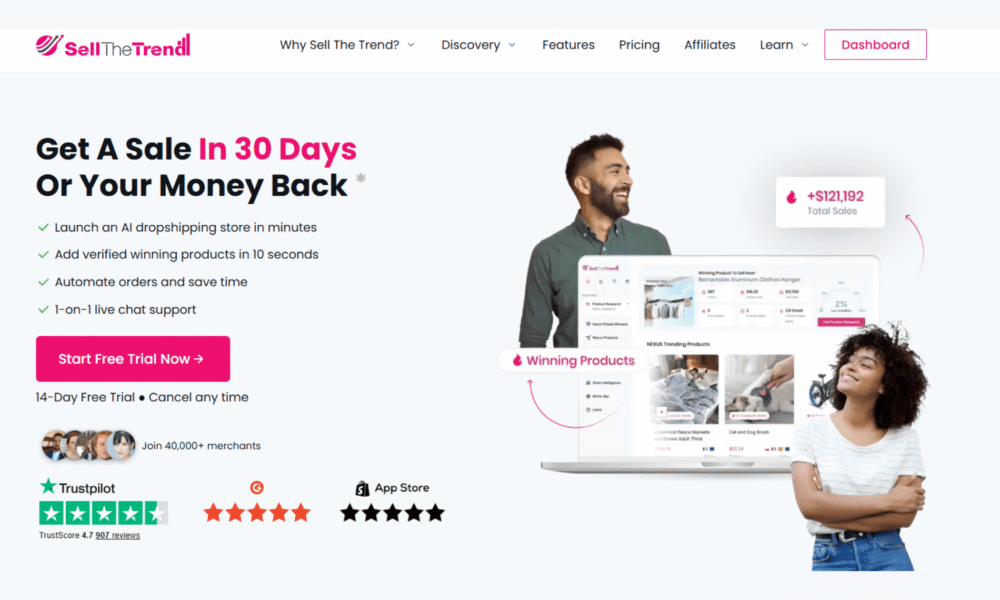If you are looking for the best Dsers Aliexpress dropshipping app alternatives,…
Is Shopify Good For Blogging Like WordPress CMS?

Are you considering starting a blog? Is Shopify good for blogging? Many people know Shopify as a popular e-commerce platform known for creating online stores.

However, Shopify also allows you to add a blog to your shop. That sounds handy. At Shopify, you can sell your products and share informative articles with your target customers. But is Shopify the blogging champion?
In this article, we’ll explore Shopify for bloggers, its pros and cons, and also break down other factors to help you decide if Shopify is good for blogging.
Table of Contents
What are the Shopify blogging features?
Shopify offers a built-in blog, a massive advantage for store owners who want to add content spice to their online shops. Let’s look at the features of Shopify blogs and the things that these features can help you do:
- Create and Publish Posts: This might sound like a no-brainer, but it’s the foundation. Shopify allows you to write text-based blog posts and add images and videos to make them more engaging. You can also publish to share your wisdom with the target audience and the world.
- Schedule Posts: Don’t have time to scramble every day to publish a new blog post? Don’t fret! At Shopify, you can schedule your posts in advance to plan your content calendar and ensure a steady stream of fresh content.
- Organize with Tags and Categories: Just like organizing your closet makes finding your favorite shirt easier, categorizing your blog posts helps readers find their interests. Shopify allows you to add tags and categorize your posts to make them easier to find.
- SEO Basics: Search Engine Optimization (SEO) is about making your website friendly for search engines. Shopify’s built-in SEO tools for your blog help with editing titles and descriptions to help people find your posts in search results quickly.
- Manage Comments: Building a community around your brand is excellent. Shopify allows you to see and manage comments on your blog posts, keeping the conversation positive and engaging.
- Sell Directly from Your Blog Posts: The Shopify store part comes here! You can easily link your blog posts to products in your store, making it super convenient for readers to buy what they see and love.
How to Use a Shopify Blog to Market Your Goods and Services?
Include a simple signup form in every blog post.
People who land on your blog post might be interested but have yet to be ready to need a toy. They may be still learning about your brand or the problem you solve.
Here’s the thing: you’ve written a blog post that informs, entertains, or solves a problem for the reader. They’ve finished reading and are thinking, “Wow, this is helpful!” Now’s your chance to keep the conversation going. This is where a simple signup form on your blog becomes a powerful marketing tool.
Start a free 3 Day trial and enjoy 3 months of Shopify for $1/month Instead of $39/month on selected plans. Sign up now
A signup form lets you capture the visitor’s vital information, like their email address. This enables you to add them to your email list, where you can nurture that initial interest. You can send those informative newsletters, exclusive offers, or even early access to new products.
A signup form doesn’t have to be complicated. A simple form asking for their email address and maybe their name is enough. By providing valuable content on your blog and a clear incentive such as a discount code or free download, you can turn those curious clicks into loyal subscribers who are more likely to become paying customers down the line.
Share the article on your various social media accounts.
Once your blog post is published, you may share it on social media rooftops. Sharing your content on popular social media platforms like Facebook, Instagram, Twitter, and Pinterest can make your work visible to a broader audience and, in turn, drive traffic back to your Shopify store.
The secret is to craft a compelling social media message alongside your blog. Don’t just post the blog title and a link; tease a key point from your post, ask a question to raise curiosity, or use emojis to grab attention.
Take your time to write a striking message that propels people to click. Tailor your message to fit each social media platform. For example, make it brief for Twitter, use eye-catching visuals for Instagram, etc. For Facebook or LinkedIn, the posts can be more descriptive, and so on.
Also, include eye-catching images and videos. People are likelier to stop scrolling if your social media post includes appealing visuals. Use a relevant image from your blog post or create a quick social media graphic to make your post stand out.
Don’t just post blogs for the sake of it; target the right platform. For social media posts, use hashtags to help get found. Including relevant hashtags in social media posts is like adding keywords to a giant online filing cabinet. People searching for those hashtags might come across your blog post and engage with it, expanding your reach.
Communicate with other bloggers.
Building relationships with other bloggers in your niche is a powerful marketing strategy for your Shopify blog. Communication is essential. Therefore, reach out to bloggers you admire whose audience aligns with your target market.
Leave thoughtful comments on their blogs, share their content on social media, or even send a friendly email introducing yourself and your Shopify store.
Explore guest blogging opportunities—you write a post for their blog, promoting your expertise and linking back to your Shopify store.
When you offer value to the other blogger and their audience, you’ll build genuine connections that can benefit everyone involved.
Pros of Using Shopify for Blogs
Shopify might not have all the bells and whistles of dedicated blogging platforms, but it has some advantages for using it for your blog. The benefits are as follows:
- Simple to Use: Shopify is designed for anyone and has a user-friendly blogging interface. No coding knowledge is required; you can create new blog posts, add images and videos, and schedule posts to publish later.
- Adaptable Selections: You are free to interact with various Shopify themes for your store. These themes often extend to your blog as well. As a result, you can ensure that your blog seamlessly integrates with the design of your store by creating a consistent look and feel for your whole online presence.
- Improve Your SEO: Search Engine Optimization (SEO) ensures your website is discoverable in search results. With Shopify’s integrated SEO tools, you can enhance your blog’s titles, descriptions, and URLs to make it easier for potential customers to find your content on search engines.
- Establish Credibility Using Blog Topics: A blog allows you to showcase your expertise and establish yourself as a thought leader in your industry. Creating clear, informative, and exciting blog posts will help you gain the trust of prospective clients. Additionally, they will regard your brand as a trustworthy information source.
- Make a Sale to a Potential Buyer: The beauty of having a blog on your Shopify store is the seamless conversion from reader to buyer. It’s easy to connect your blog posts and related products to your store, making it simple for interested readers to find what they want.
- Minimal Costs: Shopify plans have built-in blogging functionality, so you’re not paying extra to have a blog alongside your store. Doing this can cut costs associated with producing content and promoting your goods and services.
- Produces a Call to Action (CTA): A substantial blog post should have a clear call to action (CTA), encouraging readers to subscribe to your email list, download a free guide, or visit your store and check out your products. Writing blog posts for your Shopify store allows you to easily integrate CTAs, leading readers toward the next step you want them to take.
- Give Your Brand a Voice and Share Its Values: A blog is a great platform to share your brand story, values, and mission. They help you establish a stronger connection with your audience and encourage a sense of community.
- Raise awareness: A well-maintained blog is a magnet for attracting new customers. Publish top-notch content to build your Shopify store’s reputation as the authority in your niche and raise brand awareness. This will increase traffic to your website and eventually attract more potential customers to your store.
Cons of Using Shopify for Blogs
On the flip side of the coin, it’s essential to acknowledge the limitations that come with Shopify blogging before you hit publish. The cons are as follows:
Restricted Customization: Shopify’s blogging platform offers a decent selection of themes, but compared to dedicated blogging platforms, the customization options can feel limited.
Achieving a unique blog design that perfectly reflects your brand identity is challenging. At the same time, you can make adjustments with the built-in tools; extensive coding knowledge might be required to create a highly customized blog experience.
Restricted Analytical Choices: Understanding your audience is crucial for any blog’s success. However, Shopify’s built-in blog analytics provide a more basic overview than other platforms.
You might not get the granular details you crave, like in-depth traffic sources or visitor behavior, on your blog posts.
This can make it trickier to measure the effectiveness of your content and tailor your strategy accordingly. While Shopify integrates with third-party analytics tools, this might add extra costs and complexity.
Read Also:
- What Is Shopify’s Best Payment Provider?
- How To Make Your Shopify Store Live
- The Best Shopify Marketing Tools For Your Store
- 12 Side Hustle Ideas To Make Extra Money
- Klaviyo Shopify App: Ecommerce Marketing 101
Is Shopify good for blogging?
So, is Shopify the ultimate blogging champion? There needs to be a definitive answer to this question. However, if you’re a store owner who wants a simple and convenient way to add a blog and create content alongside your shop, then Shopify can be a great choice. The best platform depends on your specific needs and priorities.
A dedicated blogging platform might be better if you want complete design freedom and in-depth analytics.
However, for store owners who prioritize ease of use and a cohesive online presence, Shopify can be good for blogging. It’s even better if you already have a Shopify store. Integrating a blog into your online store and producing content that engages readers and promotes your products is easy.
Shopify is user-friendly, so you don’t need coding skills to write blog posts, add images and videos, and even schedule them to publish later.
It also helps with SEO (search engine optimization) by allowing you to optimize your blog content to be found in search results. Moreover, a blog on your website makes it simple to link to your merchandise, which facilitates readers’ conversion to paying clients.
However, Shopify is built primarily for e-commerce, so some downsides should be considered.
Compared to dedicated blogging platforms, you might need help to create a truly unique blog design or get super-detailed insights into how your blog posts perform.
Start Shopify For Only

Try Shopify free for 3 days, no credit card is required. By entering your email, you agree to receive marketing emails from Shopify.
Frequently Asked Questions (FAQs)
- Can I blog on Shopify?
Yes, you can blog on Shopify. The platform is more than just a shop; it’s a place where you can start a blog that functions as a hub for the community, an educational resource, and a branding tool.
- How do I start blogging on Shopify?
If you need help starting a blog on Shopify, don’t fret. Shopify makes it simple. Log in to your Shopify store, navigate to your admin panel, click ‘Online Store,’ and then head straight to the ‘Blog Posts’ section. Click on ‘Add Blog,’ and you’re good to go.
- Is a Shopify blog the right choice for my store?
Your needs and content strategy determine whether Shopify is the right choice for your online store’s blogging. However, as a Shopify store owner, I believe that Shopify’s blogging platform should be sufficient.
- Where do blog posts appear on Shopify?
Blog posts are hidden by default and won’t appear anywhere on your website. Setting the visibility date for a post allows you to choose when it becomes live on your website. Until you add it, it won’t be available through the site’s navigation menu.




[…] similarity between what Wix provides and WordPress services is the basis of this […]